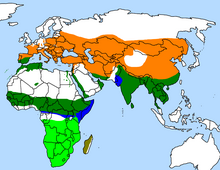- https://en.wikipedia.org/wiki/Hoopoe
- The Hoopoe’s beak is black, long and slender and slightly downward curved.
- African Hoopoes live in open, bushy regions, thorn veld and reverie woodlands in dry areas. They can also be found in parks and suburban gardens. These birds nest in cavities such as holes or crevices in tree trunks, however, they have also be known to nest in buildings, abandoned termite nests, nest boxes, piles of boulders and even under houses. They may use the same nest for many years. Nests are generally lined with grass, debris or dried manure.
-
The African Hoopoe is a forager and forages through leafs with its long, thin beak. It mainly eats insects and earthworms off the ground, however, before it actually eats the insect, the Hoopoe will bang the insect on the ground to remove legs and wings and then toss it up into the air before catching it in its open beak.
African Hoopoes will also eat frogs, small snakes, lizards and also seeds and berries in small quantities. They also eat insect pupae or larvae which they consume by probing the ground with their beak.
-
In flight, Hoopoes are low fliers with an erratic flight pattern and irregular wing beats, however, if being preyed upon by a bird of prey, it can soar very high in order to escape its predator.
-
The female Hoopoe lays around 4 – 7 eggs which are blue/green in colour but quickly become brown. The female incubates the eggs for 14 – 20 days.
-





-
-
perching bird - a bird with feet adapted for perching (as on treebranches); this order is now generally abandoned by taxonomists.
-
-
food: worms,insects, lizards, small reptiles, grains,seeds.
-
Habitat. lives in warm/dry areas. migrate in winter.
-
They are mainly found Afro-Eurasia continent.
-
Builds nest in tree cavities, rock crevices
-
Colour of their eggs: blue,green and then becoming brown.
-
Claws are for perching on the trees.
-
Beak: Strong black beak,Long thin tapering bill to probe worms etc. by digging in the ground.
-
The African Hoopoe is a forager and forages through leafs with its long, thin beak. It mainly eats insects and earthworms off the ground, however, before it actually eats the insect, the Hoopoe will bang the insect on the ground to remove legs and wings and then toss it up into the air before catching it in its open beak.
African Hoopoes will also eat frogs, small snakes, lizards and also seeds and berries in small quantities. They also eat insect pupae or larvae which they consume by probing the ground with their beak.
In flight, Hoopoes are low fliers with an erratic flight pattern and irregular wing beats, however, if being preyed upon by a bird of prey, it can soar very high in order to escape its predator.
The female Hoopoe lays around 4 – 7 eggs which are blue/green in colour but quickly become brown. The female incubates the eggs for 14 – 20 days.
perching bird - a bird with feet adapted for perching (as on treebranches); this order is now generally abandoned by taxonomists.
food: worms,insects, lizards, small reptiles, grains,seeds.
Habitat. lives in warm/dry areas. migrate in winter.
They are mainly found Afro-Eurasia continent.
Builds nest in tree cavities, rock crevices
Colour of their eggs: blue,green and then becoming brown.
Claws are for perching on the trees.
Beak: Strong black beak,Long thin tapering bill to probe worms etc. by digging in the ground.
| Scientific classification | |
|---|---|
| Kingdom: | Animalia |
| Phylum: | Chordata |
| Class: | Aves |
| Order: | Bucerotiformes |
| Family: | Upupidae Leach, 1820 |
| Genus: | Upupa Linnaeus, 1758 |
| Species: | U. epops |
| Binomial name | |
| Upupa epops Linnaeus, 1758 | |
 | |
| Approximate range. nesting resident (all year) wintering | |
No comments:
Post a Comment